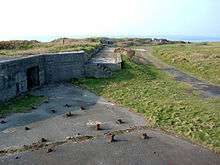Angle Peninsula Coast
The Angle Peninsula Coast is the entrance to the Milford Haven waterway in the Welsh county of Pembrokeshire. It is a Site of Special Scientific Interest. There is a wide range of wildlife and a former RAF airfield.
Landscape and wildlife
The rock pools of the windswept west angle beach are home to the rare cushion starfish. On the other side of the peninsula is Angle Bay. This bay is a wilderness of mud and sand making it a good home for invertebrates. The abundance of invertebrates means it is popular with many bird species such as dunlin, grey plover, common redshank, Eurasian oystercatcher and Eurasian curlew. The nearby Kilpaison Marsh has been a breeding area for Cetti's warbler in the reed beds and scrub.[1]
History
Above castle bay there are the remains of an Iron Age fort. On the headland there are visible remains of medieval strip farming.
World War II

Angle peninsula is rich in World War II defences and the site of former RAF Angle. The hollows in the banks around it were used to house machine guns in the Second World War and there was a searchlight battery here. Inland from East Picket bay are the remnants of the E-Pens used to house fighter aircraft if they were needed. In a field close to the World War I memorial there are the remains of an anti aircraft post. On a section of the coastal path just past the RNLI lifeboat house there are visible remains of an anti aircraft post. This site was later changed and used to house a 40 mm Rolls Royce gun. At the north hill there are remains of a Laing hut that was used as housing for a searchlight. On a rocky patch of ground at west pill is a brick mine watcher hut. This was used specifically to watch out for the enemy who may be laying mines in Milford Haven.
Angle airfield was one of the remotest airfields in Britain during World War II. The airfield opened in 1941 after Luftwaffe attacks at the town of Pembroke Dock. It began as a station for No.10 Group, Fighter Command. A few Royal Air Force (RAF) squadrons passed through Angle including Flyer Supermarine Spitfires, Westland Whirlwinds and Hawker Hurricanes. For a short while in 1943 it was passed on to the Royal Navy. During this time a Sunderland flying boat landed at Angle airfield after receiving hull damage during a rescue. It returned to the RAF and became home to the Coastal command unit who tested weapons that could be used against German U-Boats. After the war was over the buildings were no longer used and many were removed in the 1980s; however, some still stand in remote locations.
See also
References
- ↑ "Pembrokeshire Ringing Group". Retrieved 27 January 2016.
External links
| Wikimedia Commons has media related to Angle, Pembrokeshire. |
Coordinates: 51°40′49″N 5°05′52″W / 51.68022°N 5.09766°W